STEADICAM
COMMON QUESTIONS
How the Steadicam Stabilizes Camera Images
How does it work?
The Steadicam works in three ways: 1) it isolates the camera from all
but the largest movements of the operator, 2) it spreads the mass of
the camera to increase resistance to rotation, and 3) it brings the
'centre of
gravity' outside of the camera to where the operator can manipulate it
directly.
What does isolation of the camera accomplish?
Most hand-held shots suffer from a distinct jerkiness. This is because
the camera is subject to all of the movements of the operator
including the undesired shocks and bounces that accompany each
footstep. In the human body, the muscles, joints, tendons and ligaments
absorb a large portion
of these shocks; what the body does not absorb, the muscles of the eyes
and the image processing of the brain corrects for, turning a bumpy
ride into a smooth flight. .
These undesired shocks of walking consist of two elements: 1) quick
movement of the entire camera by a small amount, and 2) rotation of the
camera itself (tilt, pan, and roll). Successful isolation will
significantly reduce the size of both types of movement and the
Steadicam is designed and manufactured for successful isolation.
Isolation from whole-camera movement
This is the work of the 'Articulated Arm'. The articulating arm absorbs
the up-and-down movements of the operator, taking advantage of the mass
of the camera, as well as the mass of the 'sled', 'post' and 'gimbal'
parts
of the Steadicam.
'The Articulated Arm' Master series
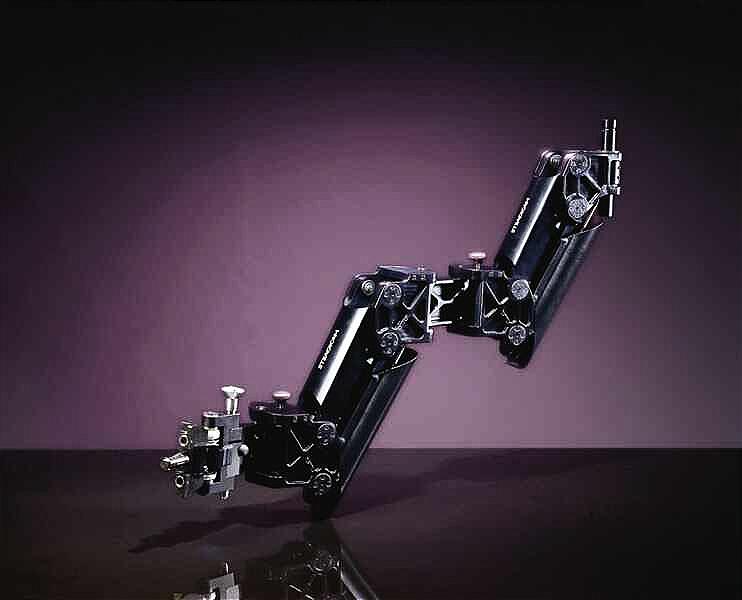
[Note: this is a picture of the arm without any weight on it. Under the
weight of the camera/sled combination, the 'bones' of the arm are
slightly below parallel to the ground, and have a range of motion from
approx. 45- above to 45- below horizontal]
Each 'bone' (see picture above) consists of a sophisticated cable,
pulley, and titanium spring shock absorption system. This shock
absorption balances the tension in the arm, so that it takes as much
effort for the operator to lower the rig as to raise it.
The Articulated Arm absorbs the vertical shocks transmitted with
each
footstep. Under the weight of the camera/sled combination, the
articulated
arm averages out these shocks. Since each upward shock is matched by a
downward
shock, this averaging effectively nullifies the bounce of each
footstep,
isolating the camera from the Operator's footsteps.
The key to this isolation is the mass of the camera/sled
combination.
This is where rigs capable of handling heavier cameras, like the 3A,
the
Ultra, and the PRO Sled have an advantage over rigs designed for
lighter
cameras, like the Flyer and, to a smaller degree, the EFP. The larger
the
mass of the camera/sled combination, the more resistant that
combination
is to movement; the more resistant the combination, the easier it is
for
the arm to average out larger shocks.
This mass also resists side-to-side and front-to-back whole camera
movement; however, without the added complication of gravity, the
sturdy but free-moving hinges on the arm are all that's necessary to
isolate the camera from the small side-to-side movements of walking.
Spreading the Camera's Mass
Imagine this: you're trying to launch a rocket at the moon, and it will
only fly in the direction that its nose points, just like a camera will
only shoot where its lens points. If you move it one hundred miles
(ignoring
the curvature of the earth) and point it at precisely the same angle,
in
the process using 100 gallons of gas, you'll still hit the moon. If,
however,
you use one-quarter gallon of gas to change the angle of the rocket by
one
degree, you'll miss the moon completely.
This is why camera rotation, rather than whole-camera movement, is
the primary enemy of stable images. It just takes a lot less energy to
tilt, pan, or roll the camera than to displace the entire camera, yet a
small
change in camera angle has a much greater effect than even a big change
in camera position.
The Steadicam fights this rotational instability by increasing the
cameras 'Moment of Intertia'. An object with a high Moment of Inertia
is more resistant to rotation (nothing like a circular argument when
discussing rotation).
The camera is mounted on one end of the 'Post', and the battery and
monitor (and whatever special electronics the operator has added) are
mounted to the other end. This increases the Moment of Inertia. Now,
the weight of the camera and the battery and monitor are located at a
greater distance from the point around which the rig rotates -- the
'gimbal' see picture below.
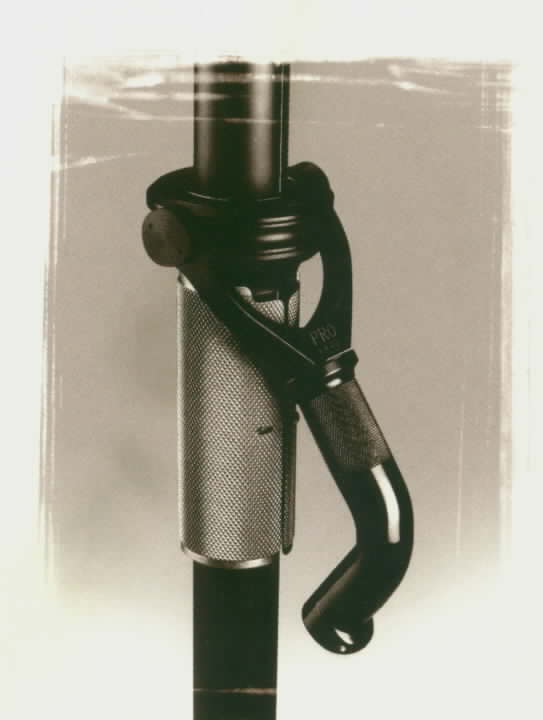
PRO GIMBAL
. The added distance (and weight) means that the camera moves much
faster when rotated at the gimbal -- just like the outer edge of a
record (remember them?) moves much faster than the inner edge at the
spindle. Since the
camera moves faster at the end of the post than it would if mounted at
the
gimbal, it takes more effort to rotate the the camera. (This is why
high-wire
walkers use a very long pole to help them balance -- instead of
increasing
weight, they increase length, so the pole increases stability much more
than just sticking their arms straight out to their sides)
In conjunction with the increased moment of inertia, the Steadicam
isolates the camera from rotation with its nearly frictionless gimbal
(I've heard the Ultra Series operates with such apparent disregard for
friction that
it elicits gasps from members of the crew). Interestingly, the easier
it
is for the gimbal to rotate, the less likely the Steadicam itself will
rotate. This is because the unwanted rotation travels up the
articulated arm, rather than originating in the rig. The arm rotates
relative to the rig. If there is significant friction in the gimbal,
this friction acts as a rotational force; without significant friction,
the rotational forces aren't transmitted, and the camera doesn't rotate
unless the operator tells it to.
Newtons Laws of Motion.
An object at rest tends to stay at rest and an object in motion
tends to
stay in motion with the same speed and in the same direction unless
acted upon by an unbalanced force.
When a force acts upon a body, it imparts an acceleration proportional
to the force and inversely proportional to the mass of the body and in
the direction of the force.
Every action has an equal and opposite reaction.
Where are the gyroscopes hidden?
Contrary to popular belief, and even some published reports, there are
normally no gyroscopes in a Steadicam! The Steadicam stabilizes with
balance, isolation, and inertia. Gyros can help in specific, rare
instances -- excessive wind, Steadicam shots used as plates for special
effects (ie.. ~Return of the Jedi~ forest chase [operated by the
Steadicam's inventor, Garret Brown])
Can I use a
teleprompter with a Steadicam?
Yes we use these all the time in television. We prefer the 8”
LCD type (see picture). We have our own 8" LCD prompter
which most clients are happy with. Many prompters are available
with a radio link or we
can supply a very fine coax cable. Power usually taken from the
Steadicam rig.
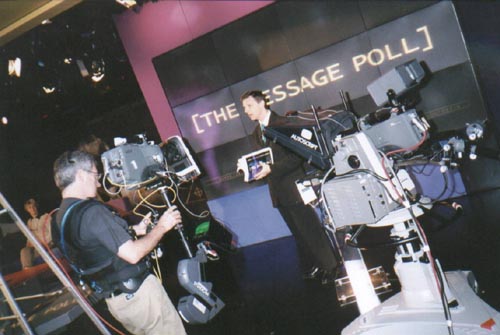
So how do you control it now that you're isolated from it?
The big Steadicam secret: the job of the operator is not to remove
instability; the operator's job is to shoot without adding any.
Now that we've invested all this engineering in isolating the camera
from the operator, how can the operator control the camera without
ruining all that work? A camera moving without any additional control
may be smooth, but the footage would be pretty much pointless. So how
can the operator
manipulate the frame without adding the dreaded rotation the Steadicam
is
designed to isolate? The answer is: the operator manipulates the
camera
at its 'Centre of Gravity'
What is the Centre of Gravity?
There is one place on any object where you can push, pull, tug, yank,
or throw it without adding rotation: its 'Centre of Gravity' (which I
will be calling the 'Centre of Mass' throughout the rest of the
document).
[The terms "Centre of Gravity" and "Centre of Mass" are equivalent
in
this context; any difference between the two is far smaller than the
precision with which human fingers can make adjustments. There are
certain contexts where the difference would be significant -- in
free-fall, zero gravity, or in places with massive tidal gravity, such
as near the event horizon
of a black hole. However, most budgets do not cover the hazard pay
required
for such situations.]
A short ruler (say, 6 in. or 15 cm) illustrates the concept of
Centre
of Mass. If you attempt to push this ruler across your desk using just
one
finger at, say, the 1 inch or 2.5 cm mark, it rotates out from in front
of
your finger. If you attempt to push much closer to its centre of mass
(the
3 in. or 7.5 cm mark), you can push it indefinitely across your desk
with
only slight adjustments along the way (The actual Centre of Mass is in
the
centre of ruler, where it would balance on a fingertip).
The 'Centre of Mass' is the point at which an object is in balance
in
all three dimensions. In most cameras, this point is located deep
inside
the camera, where the operator cannot get within a few inches of it.
Unable
to reach the Centre of Mass, the operator has to control not only the
image, but the operator's own added rotation -- which significantly
increases
instability.
No, really, where are the gyroscopes?
Again, there are no gyroscopes. Gyroscopes are massive objects, which
take a great deal of energy to operate (more battery power means more
weight), and which increase mechanical complexity. Part of the magic of
the Steadicam is that it achieves its effects (except the external view
screen) without added power -- just mass, balance and inertia.
Gyros can and are used by some operators. They can be useful in windy
situations and on fast moving vehicles
What is the Steadicam well suited for?
Moving camera shots in tight quarters. [Where a dolly would bang into
walls, door jambs, or trees]
Shots over rough ground, particularly where one needs to look
straight ahead or behind.
Where one needs to continue on beyond the practical distance that
can
be accommodated with track.
Where any other technique for moving the camera would be impractical
for external reasons, such as the load-bearing abilities of the floor
or the rigidity of a dock or bridge, etc. for any moving camera shot
where the quality of the move contributes to the emotional qualities of
the scene, such as the
"hardness" of accelerations/decelerations, pans, etc., and the
momentary control
over the balanced/unbalanced nature of the composition as actors enter
or
are let out of the frame.
Where one needs to isolate the camera from the movement of a vehicle
(virtually any vehicle) for any reason, for instance: 1) where we wish
to perceive the on-screen vehicle's motion within our frame, or 2)
where we wish to negate the movement of our off-screen vehicle so it
doesn't effect our shot of
some other subject.
Where we wish to simulate vehicle motion within a set that doesn't
move (such as the work in the airplane set in ~The Twilight Zone[: The
Movie]~ or ~Mutiny on the Bounty~)
Where we wish to provide the effect of a zoom lens of much greater
range than any available, by moving toward or away from a subject
(perhaps while zooming slightly)
For human or animal (or alien) points of view, that move through the
world realistically, but don't shake unrealistically.
For quick static shots with simple set ups, where time is a factor -
such as during a sunset, or in the middle of a series of Steadicam
shots, or when shooting VIP's on tight schedules where changing cameras
and bringing in
a dolly would be an unnecessary waster of effort.
Where unpredictable events preclude marks -- like shooting dogs and
kids and non-actors and rainbows!
Or for various extremely ! technical shot requirements, such as
certain kinds of optical plates, or shots that need to pan around
diverse axes...
What is a Steadicam not well suited for?
Static shots on long focal lengths.. although this can be a nice look
for some.
Ultra-violent actions with running, etc. (Why risk falling or
crashing with a £30,000 rig plus camera? This kind of thing is
perfect for
"shaky-cams" and "Pogo-cams" that don't have to be rock steady, and
that
mostly don't need video viewfinding)
Quick pans with instantaneous lock-offs (This can be murder, even on
a tripod, because of the viewfinding problem, and it's perhaps best
done on a geared head. However Steadicam is getting to be a close
second. Rapid tilts are even more difficult -- that is the most
inert axis of the Steadicam
For mounting/carrying on things that regularly crash: skis, skates,
horses, helicopters, vehicles in violent motion... Again, shaky-cam is
great for stunt vehicle shots, including skates, because if [the
operator] falls, at least [he or she isn't] welded to it and can toss
it away. [Productions wishing to shoot from vehicles that travel at
high speeds with quick turns, such as stunt helicopters and racing
boats, should consider renting a gyroscope-based camera stabilizing
system, in which the camera stays in place relative
to the vehicle and all whole-camera movement is achieved by moving the
vehicle.]
For any shots that can be easily and perfectly executed on the
dolly.
Why carry it ~if it can ride just as well!~
How much would it cost to hire a rig and operator?
The general rate in the UK at the moment varies between operators due
to experience and type of equipment but a ball park figure for
television work is between £600 and £900 per day including
equipment (see Rate Card) It is often very productive to employ a good Steadicam
focus assistant to help with the shoot
What other equipment might the operator have?
Video Tap -- for film cameras. This is essential. Because the monitor
on every Steadicam is fed by a video signal, a film camera without a
video tap means that the operator will have to shoot without an image,
Bad Idea.
Remote Focus/Genio (see Rate Card)
Since touching the lens barrel would severely hamper the
isolation of the rig, focus, if you want to control it, should only be
done remotely. This will take a little longer to set up than a camera
without; and, importantly, the focus puller should be someone familiar
with remote focusing -- which is why most full-budget film shoots hire
a Steadicam Assist with the Steadicam operator.
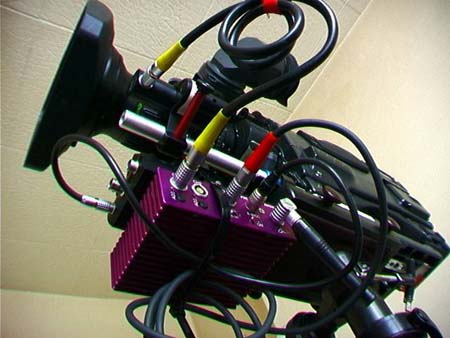
GENIO RADIO CONTROLLED FOCUS/IRIS & CAMERA START
STOP
Remote Iris or Zoom -- If you want to control either of these during
a shot, say if the camera passes from inside to outside, than you will
need the Iris as well. Generally, the same controller will run Focus,
Iris, And zoom.
A tally light is often useful for the operator and the talent in front
of camera
2nd monitor to see transmission and other cameras or sources
Video Zoom Control, Bebob. Instead of controlling the zoom from
external motors, like a remote focus, the Bebob uses the Lens's own
power zoom, operating much like the controls in the lens hand-grip. If
you think that control might
be useful to your shoot, be sure to tell your Steadicam Operator the
Make
and Model of your video camera's zoom lens, so the operator can be sure
to have the proper cables, if available.
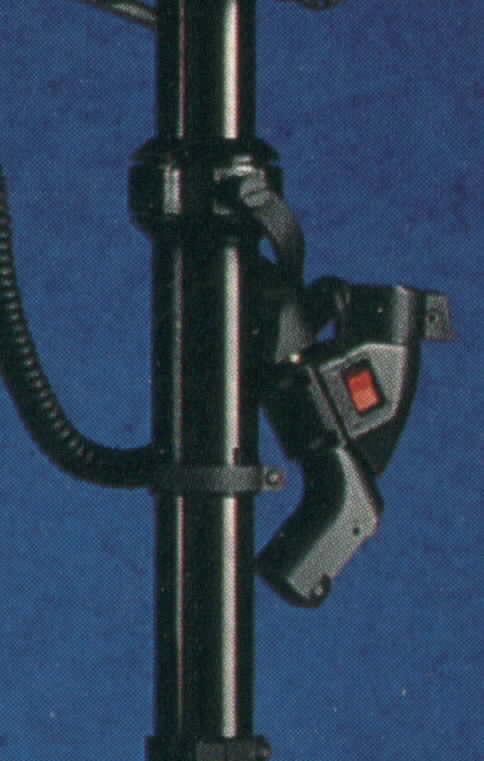
ZOOM CONTROL
What about low budget films and student work?
Even though an operator's day rate may exceed the budget of your
production, if the project is well-planned and legitimate, there is a
good chance you might find an operator to shoot it on a lower rate or
equipment only basis. In fact, if your project offers a challenge that
the operator would like to work on (i.e. it's film, and the operator
usually works in video, or a shot that will look particularly good in
the operator's reel), you may find the operator quite eager.
One thing you must be sure of -- get the operator a copy of the final
project on high-quality video the instant it's ready. Operators,
especially
the young ones most likely to volunteer, live and die by the demo reel,
and your project's footage is going to be vital to that reel.
Can I get a Steadicam for shooting video?
Yes all Steadicams should work well with your video camcorder if it
weighs enough. Even when flying film cameras, all Steadicams use a
video reference, usually provided with a video tap or assist. A simple
video out from the camcorder
will work wonderfully.
The biggest problem associated with using the Steadicam to shoot video
is not the camera but the cables. Ideally, no cables should attach to
the camera unless they end somewhere on the camera or rig. One _very_
thin cable leading from the rig will generally not interfere with the
operator's work, although someone must work as a cable puller to keep
that cable out from under everyone's feet. Large cables, like power
cords and triax, can ruin a shot by negating the isolation of the
Steadicam, making the shots unsteady and even "seasick."
At Joemac we have specially made ultra lightweight Triax adapters that
allow us to use all broadcast cameras with very little affect on the
rig
In all the setup for a video cameras on a Steadicam is often both
easier and quicker than with a film camera, since there is no need for
an additional video tap.
What are the differences between the various models?
There are many different models.
The Ultra Series, the 3A, and many modified rigs can handle cameras
weighing up to 40 lbs.; in the field, this means that they can support
cameras such as Arri BL's and the Panaflex Platinum conversion very
well, and Panavision Gold, some 65mm and Imax cameras at the limits of
their range. [Note: although a Steadicam can handle cameras as heavy as
the Gold, a lighter camera will usually allow the operator longer and
more frequent takes, with less downtime between takes]
In general any TV camera that is designed for use on the operators
shoulder can be carried on the rig. The biggest problem with TV cameras
is that some of them can be too light and we sometimes have to add
small weights to increase mass.
TV cameras like the Digibeta 700/790, DVcam 570, HDcam 900 and 750 are
ideal. Sony Z1 is perfect on the Flyer
The Master Series
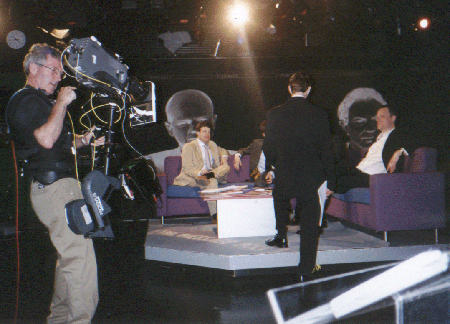
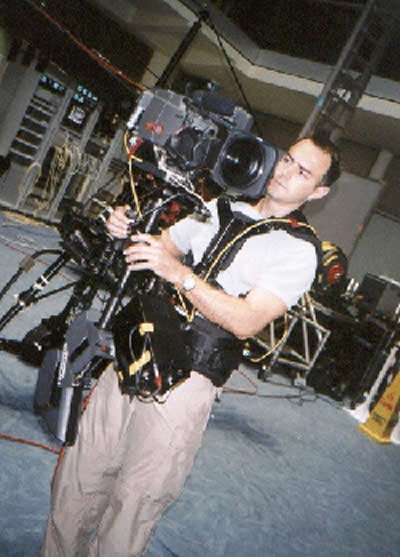

ULTRA SERIES RIG IN ACTION
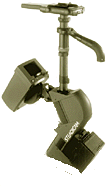
This is the newest and most expensive model. It can fly 35mm cameras
up to the Panavision gold, and even some 65mm cameras as well as all TV
cameras.
Features of the Steadicam Ultra Series:
- Arm, vest, and gimbal strength to handle cameras weighing up to
40 lbs.
- The smoothest Steadicam gimbal, exhibiting almost no friction.
- The industry's brightest and largest screen
- Inside-the-post wiring
- Design for easier dynamic balance (helps prevent bottom from
swinging out during pans)
- A significantly re-engineered articulated arm, for easier
booming, and the ability to stay at the height the operator booms to,
rather than returning to neutral.
- "No-tools" adjustments of the vest, arm, and sled. The other
models require adjustments with hex- wrenches -- if they even offer
adjustments.
The Steadicam 3A
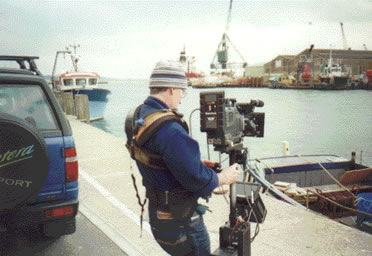
This has been the workhorse in the 35mm film industry for the last
twenty years.
Features of the 3A:
- Arm, vest, and gimbal strength to handle cameras weighing up to
40 lbs.
- Bright, high-voltage green monochrome monitor and electronics
- X - Y adjustments for the sled in addition to the camera,
simplifying balance fine-tuning
- External cabling (not up the post)
Can I build a full-sized Steadicam?
The primary factor that makes the construction of a Steadicam expensive
is the same factor that makes purchase of a Steadicam expensive:
engineering.
The Steadicam design is constrained most by one thing: the human body.
All the weights, stresses, and forces must be within the comfort range
of a human operator in good health. This means that many solutions
available to ground- or vehicle-based rigs are just not applicable; to
gain strength, for instance, you can't just add material to increase
cross-sections. To increase inertia, you can't just add mass. Because
of this, the biggest factor
in determining the price of a rig is the weight of the camera that it
can
handle.
Each element of the Steadicam has its own engineering challengers. The
post must not flex, even at its full length; otherwise, quick starts
and stops would be difficult to control. The camera mounting must be
able to support the camera both upright, and when reversed in low mode,
while being adjustable in both front to back and side to side
directions to a fraction of a millimeter. The gimbal must be virtually
without friction, must still rotate 360 degrees on three axes, and must
be able to withstand the forces of a rig in motion. The vest should
distribute the weight and the forces of a rig in motion, must be sturdy
enough to rigidly hold the arm in its socket,
and must be adjustable for a number of different body types.
The most sophisticated engineering, however, is reserved for the
Articulated Arm. This arm accounts for half of the cost of the rig. The
arm must support the weight of the rig and camera at the approximate
mid-point of its vertical travel. Under this tension, it is easy to
move the arm and control the
vertical position, because pushing down requires the same force as
pulling
up. (Two models make this even more challenging: the SK and the Master.
With both models, the arm stays at the height the operator leaves it.
With
other models, the operator needs to keep pushing down or pulling up to
hold
the camera at any height other than neutral). To make the arm work, the
Steadicams
use a combination of pulleys, cables, and titanium springs (no other
material is strong enough).
Eventually, the economics add up: the amount of personal time,
materials, and machine shop time will likely exceed the value of a
Steadicam purchased new. And, while a Steadicam is not inexpensive by
any means, its resale
value means that the owner has a valuable, saleable asset. The resale
value
of a homemade camera stabilizer, however, approaches zero (and may even
go
negative!) the closer the design is to the Steadicam (or any other
patented
design).
What does it take to become a Steadicam operator?
Practice, man, practice.
Back to FAQ
Do I need to be big and strong to become a Steadicam Op?
Not necessarily. Strength -- and especially endurance -- will improve
your performance as an operator; however, you don't need to be in the
top 1% physical condition to be an operator.
What you will need are:
- No back problems
- All-around good physical shape
- No problems with dizziness or disorientation
- A camera operator's good eyesight.
- A working knowledge of the film and/or video industries.
You will likely benefit from having the following:
- Experience as a Camera Operator
- A thorough understanding of Newtonian physics (see laws)
- Skill with tools
- Having a blood relative who owns a major film or TV production
company.
For more information on requirments for becoming an operator check out
the BBC health and safety site
http://www.bbc-safety.co.uk/guidance/steadicam.html
Most operators need to do a special test which involves having your
head examined !
What are some Good examples of Steadicam work?
The Steadicam has been in use since the mid-70's, with most of us being
introduced to it in what was supposed to be a little film: a sleeper
about a boxer in Philadelphia. The film was ~Rocky~, and the memorable
Steadicam sequence followed Sylvester Stallone as he charged in triumph
up the Philadelphia Courthouse steps.
Since then, the Steadicam has been used in everything from music videos
to amusement park rides. However, the most readily available Steadicam
footage can be found in feature films. Two films that demonstrate well
the Steadicam's abilities in skilled hands are: ~The Shining~,
Steadicam
by Garret Brown, and ~The Fugitive~, Steadicam by Steve St. John
(Chicago)
and Bob Ulland (North Carolina).Marathon Man, Casino, Goodfellas, The
Fugitive,
Much Ado.
In my opinion some good TV steadicam would include ER, Sopranos, a lot
of the sport coverage, soap operas,So Graham Norton. A lot of steadicam
work
in TV drama and entertainment goes unnoticed as it fits seamlessly into
the production i.e. doesnt draw attention to itself.
The Shining
Even though ~The Shining~ was shot during the infancy
of Steadicam technology, the Steadicam heavily influenced the
production's
feel, especially in exploring the huge, ominous spaces of the Overlook
Hotel.
Three Steadicam sequences stand out as the most memorable:
- Following the Big Wheel. Little Danny (Danny Lloyd) kills time (not
the last thing to get killed in the film) by riding his Big Wheel
plastic
tricycle through the lobby and Hallways of the Overlook Hotel. The
camera
follows Danny, as he rolls from the hardwood floor (very noisy) to
carpeting
(much quieter) back to hardwood. The combined effect -- the low camera
angle, the alternate roar and silence of the tricycle's wheels, and the
emptiness of the hotel -- all give a sense of something about to
happen,
and then Little Danny rounds a corner and finds... someone.
- Jack (Jack Nicholson) and Wendy Torrence (Shelly Duvall) fight on a
grand staircase. The camera looks over Wendy's shoulder at Jack (in one
of those defining Jack Nicholson moments) as he follows her up the
stairs.
- Danny running from Jack through the hedge maze. At the end of the
film, Jack has decided to kill his family. Danny tries to run away by
going into the hedge maze on the Overlook Hotel grounds. As Danny runs,
the camera
follows him. In other shots, the camera leads Jack. In a few shots, the
camera takes Jack's POV.
One thing common among these shots is that the camera shows the floor
or ground. With a dolly, looking ahead or behind would reveal the
tracks,
in sequences like the Big Wheel, would have required an incredible
length
of track. To illustrate the size and loneliness of the hotel, the
camera
often shoots from a great distance, including most of the room --
including
the floor! -- in every shot. Throughout ~The Shining~, the Overlook
Hotel
gets most of the frame.
The Fugitive
~The Fugitive~ is an excellent example of modern, non- intrusive
Steadicam technique. No scene stands out as a Steadicam shot; the
Steadicam shots
blend smoothly with all of the tripod and dolly shots. Whether running
through lobbies, walking through apartments, or charging through
ballrooms, the
characters are usually lead by the camera -- and that leading camera is
the Steadicam. With the Steadicam, the actor can move freely in line
with
the camera (so that the camera sees their faces) without stepping on or
over tracks. And the characters in this movie are almost always on the
move.
Anything I have worked on !!!!!!!
(ok just kidding)








